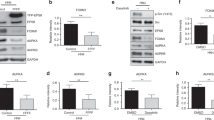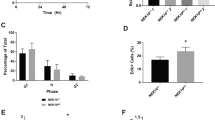Abstract
The p53 tumor suppressor protein is mutated in more than 50% of all human cancers, which makes the study of its functions and activities critical for the understanding and management of cancer. In response to cellular stresses, p53 is activated and can mediate cell cycle arrest and/or apoptosis via the upregulation of numerous target genes. Here, we have identified EphA2 as a target gene of the p53 family, that is, p53, p73, and p63. We also found that an increase of EphA2 transcript levels correlated with an increase of EphA2 protein expression, and induction of EphA2 in response to DNA damage corresponded with p53 activation. Furthermore, we identified a p53 response element located within the EphA2 promoter that is responsive to wild-type p53, p73, and p63, but not mutant p53. Interestingly, the ligand for EphA2, ephrin-A1, is also regulated by p53. EphA2 and ephrin-A1 are members of the Eph family of receptor tyrosine kinases and ligands, which are implicated in a number of developmental processes. To analyse the role of EphA2 in p53-mediated tumor suppression, we generated stable cell lines capable of expressing exogenous EphA2 in a tetracycline-repressible system. We found that EphA2 expression resulted in an increase in apoptosis. Thus, we hypothesize that the activated EphA2 may serve to impair anti-apoptotic signaling, perhaps by disrupting focal adhesions and thereby sensitize cells to pro-apoptotic stimuli.
This is a preview of subscription content, access via your institution
Access options
Subscribe to this journal
Receive 50 print issues and online access
$259.00 per year
only $5.18 per issue
Buy this article
- Purchase on Springer Link
- Instant access to full article PDF
Prices may be subject to local taxes which are calculated during checkout







Similar content being viewed by others
Abbreviations
- HA:
-
hemagglutinin
- PBS:
-
phosphate buffered saline
- kb:
-
kilobase
- bp:
-
base pair
- FACS:
-
fluorescence-activated cell sorting
- HPV:
-
human papilloma virus
- nt:
-
nucleotide
- FAK:
-
focal adhesion kinase.
References
Agarwal ML, Taylor WR, Chernov MV, Chernova OB, Stark GR . 1998 J. Biol. Chem. 273: 1–4
Bartley TD, Hunt RW, Welcher AA, Boyle WJ, Parker VP, Lindberg RA, Lu HS, Colombero AM, Elliott RL, Guthrie BA, Holst PL, Skrine JD, Toso RJ, Zhang M, Fernandez E, Trail G, Varnum B, Yarden Y, Hunter T, Fox GM . 1994 Nature 368: 558–560
Candau R, Scolnick DM, Darpino P, Ying CY, Halazonetis TD, Berger SL . 1997 Oncogene 15: 807–816
Chen C, Okayama H . 1987 Mol. Cell. Biol. 7: 2745–2752
Chen X . 1999 Mol. Med. Today 5: 387–392
Chen X, Ko LJ, Jayaraman L, Prives C . 1996 Genes Dev. 10: 2438–2451
Cheng HJ, Nakamoto M, Bergemann AD, Flanagan JG . 1995 Cell 82: 371–381
Committee EN . 1997 Cell 90: 403–404
De Laurenzi V, Costanzo A, Barcaroli D, Terrinoni A, Falco M, Annicchiarico-Petruzzelli M, Levrero M, Melino G . 1998 J. Exp. Med. 188: 1763–1768
De Laurenzi VD, Catani MV, Terrinoni A, Corazzari M, Melino G, Costanzo A, Levrero M, Knight RA . 1999 Cell Death Differ. 6: 389–390
Dohn M, Zhang S, Chen X . 2001 Oncogene 20: 3193–3205
el-Deiry WS, Kern SE, Pietenpol JA, Kinzler KW, Vogelstein B . 1992 Nat. Genet. 1: 45–49
el-Deiry WS, Tokino T, Velculescu VE, Levy DB, Parsons R, Trent JM, Lin D, Mercer WE, Kinzler KW, Vogelstein B . 1993 Cell 75: 817–825
Flanagan JG, Vanderhaeghen P . 1998 Annu. Rev. Neurosci. 21: 309–345
Frisch SM, Vuori K, Ruoslahti E, Chan-Hui PY . 1996 J. Cell. Biol. 134: 793–799
Frisen J, Holmberg J, Barbacid M . 1999 EMBO J. 18: 5159–5165
Frisen J, Yates PA, McLaughlin T, Friedman GC, O'Leary DD, Barbacid M . 1998 Neuron 20: 235–243
Gale NW, Holland SJ, Valenzuela DM, Flenniken A, Pan L, Ryan TE, Henkemeyer M, Strebhardt K, Hirai H, Wilkinson DG, Pawson T, Davis S, Yancopoulos GD . 1996 Neuron 17: 9–19
Guilford P . 1999 Mol. Med. Today 5: 172–177
Gumbiner BM . 1996 Cell 84: 345–357
Harper JW, Adami GR, Wei N, Keyomarsi K, Elledge SJ . 1993 Cell 75: 805–816
Henkemeyer M, Orioli D, Henderson JT, Saxton TM, Roder J, Pawson T, Klein R . 1996 Cell 86: 35–46
Holder N, Klein R . 1999 Development 126: 2033–2044
Hollstein M, Rice K, Greenblatt MS, Soussi T, Fuchs R, Sorlie T, Hovig E, Smith-Sorensen B, Montesano R, Harris CC . 1994 Nucleic Acids Res. 22: 3551–3555
Hollstein M, Sidransky D, Vogelstein B, Harris CC . 1991 Science 253: 49–53
Hungerford JE, Compton MT, Matter ML, Hoffstrom BG, Otey CA . 1996 J. Cell. Biol. 135: 1383–1390
Ilic D, Almeida EA, Schlaepfer DD, Dazin P, Aizawa S, Damsky CH . 1998 J. Cell. Biol. 143: 547–560
Johansen FE, Prywes R . 1994 Mol. Cell. Biol. 14: 5920–5928
Jost CA, Marin MC, Kaelin Jr WG . 1997 Nature 389: 191–194
Kaelin WG . 1999 Oncogene 18: 7701–7705
Kaghad M, Bonnet H, Yang A, Creancier L, Biscan JC, Valent A, Minty A, Chalon P, Lelias JM, Dumont X, Ferrara P, McKeon F, Caput D . 1997 Cell 90: 809–819
Levine AJ . 1997 Cell 88: 323–331
Levrero M, De Laurenzi V, Costanzo A, Gong J, Wang JY, Melino G . 2000 J. Cell. Sci. 113: 1661–1670
Lindberg RA, Hunter T . 1990 Mol. Cell. Biol. 10: 6316–6324
Mellitzer G, Xu Q, Wilkinson DG . 1999 Nature 400: 77–81
Miao H, Burnett E, Kinch M, Simon E, Wang B . 2000 Nat. Cell. Biol. 2: 62–69
Miao H, Wei BR, Peehl DM, Li Q, Alexandrou T, Schelling JR, Rhim JS, Sedor JR, Burnett E, Wang B . 2001 Nat. Cell. Biol. 3: 527–530
Miyashita T, Reed JC . 1995 Cell 80: 293–299
O'Leary DD, Wilkinson DG . 1999 Curr. Opin. Neurobiol. 9: 65–73
Osada M, Ohba M, Kawahara C, Ishioka C, Kanamaru R, Katoh I, Ikawa Y, Nimura Y, Nakagawara A, Obinata M, Ikawa S . 1998 Nat. Med. 4: 839–843
Ozaki T, Naka M, Takada N, Tada M, Sakiyama S, Nakagawara A . 1999 Cancer Res. 59: 5902–5907
Prives C, Hall PA . 1999 J. Pathol. 187: 112–126
Rodriguez-Fernandez JL . 1999 Bioessays 21: 1069–1075
Scheffner M, Huibregtse JM, Vierstra RD, Howley PM . 1993 Cell 75: 495–505
Schmale H, Bamberger C . 1997 Oncogene 15: 1363–1367
Senoo M, Seki N, Ohira M, Sugano S, Watanabe M, Inuzuka S, Okamoto T, Tachibana M, Tanaka T, Shinkai Y, Kato H . 1998 Biochem. Biophys. Res. Commun. 248: 603–607
Shimada A, Kato S, Enjo K, Osada M, Ikawa Y, Kohno K, Obinata M, Kanamaru R, Ikawa S, Ishioka C . 1999 Cancer Res. 59: 2781–2786
Smith CL, Hager GL . 1997 J. Biol. Chem. 272: 27493–27496
Sonoda Y, Matsumoto Y, Funakoshi M, Yamamoto D, Hanks SK, Kasahara T . 2000 J. Biol. Chem. 275: 16309–16315
Trink B, Okami K, Wu L, Sriuranpong V, Jen J, Sidransky D . 1998 Nat. Med. 4: 747–748
Ueda Y, Hijikata M, Takagi S, Chiba T, Shimotohno K . 1999 Oncogene 18: 4993–4998
van der Geer P, Hunter T, Lindberg RA . 1994 Annu. Rev. Cell. Biol. 10: 251–337
Xu Q, Mellitzer G, Robinson V, Wilkinson DG . 1999 Nature 399: 267–271
Yang A, Kaghad M, Wang Y, Gillett E, Fleming MD, Dotsch V, Andrews NC, Caput D, McKeon F . 1998 Mol. Cell. 2: 305–316
Yang A, McKeon F . 2000 Nat. Rev. Mol. Cell. Biol. 1: 199–207
Yang A, Walker N, Bronson R, Kaghad M, Oosterwegel M, Bonnin J, Vagner C, Bonnet H, Dikkes P, Sharpe A, McKeon F, Caput D . 2000 Nature 404: 99–103
Yu J, Zhang L, Hwang PM, Rago C, Kinzler KW, Vogelstein B . 1999 Proc. Natl. Acad. Sci. USA 96: 14517–14522
Zaika AI, Kovalev S, Marchenko ND, Moll UM . 1999 Cancer Res. 59: 3257–3263
Zantek ND, Azimi M, Fedor-Chaiken M, Wang B, Brackenbury R, Kinch MS . 1999 Cell. Growth Differ. 10: 629–638
Zhao R, Gish K, Murphy M, Yin Y, Notterman D, Hoffman WH, Tom E, Mack DH, Levine AJ . 2000 Genes Dev. 14: 981–993
Zhu J, Chen X . 2000 Mol. Cell. Biol. 20: 5602–5618
Zhu J, Jiang J, Zhou W, Chen X . 1998a Cancer Res. 58: 5061–5065
Zhu J, Zhou W, Jiang J, Chen X . 1998b J. Biol. Chem. 273: 13030–13036
Zhu KJW, Zhu J, Jiang J, Shou J, Chen X . 1999 Oncogene 18: 7740–7747
Acknowledgements
We would like to thank Dr R Markowitz, S Nozell and A Willis for critical reading of this manuscript. We also thank Dr T Hunter for EphA2 cDNA (pNeoMSV-EphA2) and Dr B Wang for suggestions. This work is supported in part by Grants R29 CA76069 and RO1 CA81237 from the National Institutes of Health and Grant DAMD 17-97-1-7019 from the United States Department of Defense Breast Cancer Research Program.
Author information
Authors and Affiliations
Corresponding author
Rights and permissions
About this article
Cite this article
Dohn, M., Jiang, J. & Chen, X. Receptor tyrosine kinase EphA2 is regulated by p53-family proteins and induces apoptosis. Oncogene 20, 6503–6515 (2001). https://doi.org/10.1038/sj.onc.1204816
Received:
Revised:
Accepted:
Published:
Issue Date:
DOI: https://doi.org/10.1038/sj.onc.1204816



